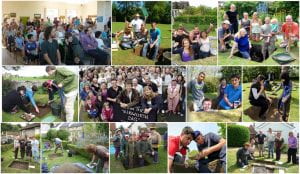The CORS project has been intrinsically publicly engaged from start to end, with the 2500+ excavations all carried out by members of the public. These have included 7000+ teenagers carrying out test pit excavations as part of the Higher Education Field Academy (HEFA) (later ILAFS) in order to boost their academic skills, knowledge, confidence and aspirations. In addition, thousands of people living in or around the settlements have carried out many more test pit excavations, some as one-offs alongside HEFA students, others as part of community projects with scores of participants ranging in age from 8 months to over 80 years. 
Beyond carrying out the excavations, members of the public have been involved in all stages of the excavations, from deciding where to site the test pits to discussing the significance of the discoveries and contributing their own knowledge to enable these to be more effectively contextualised.
As well as the archaeological finds, a commitment to evaluating learning outcomes and collecting feedback from participants has generated a large amount of data showing the impact on people of taking part (key publications listed at the bottom of this page). These data have demonstrated a wide range of benefits from enhanced skills and raised aspirations to increased place attachment and life satisfaction, and the robust evidence they provide for social benefit has helped similar projects develop much further afield, from Leicestershire, Worcestershire and Cardiff (the latter under 2020 lockdown!) to several countries in Europe, where public participation in archaeological excavation has previously been almost unheard of.
There have been scores of public talks given about the CORS test pit excavations, with dozens usually taking place each year, including talks about the results in participating villages, to ensure the results are returned to their host communities. The COR excavations have been featured in many different fora – they have been part of Michael Wood’s ‘Story of England‘ TV series in 2012 and Great British Story in 2014, have been part of the 2012 London Olympic Games (Lewis 2013 below), and we have even explored the potential of test pit excavation in the mysterious village of Ambridge, the home of the world’s longest soap opera, BBC Radio 4’s The Archers! (Lewis and Cooper, below).
One of many new perspectives to emerge from the CORS excavations which has been of great interest to many people (even more so since the 2020 coronavirus pandemic) has been on the impact of the 14th Black Death on medieval rural settlements, and there’s a film of a talk by Carenza Lewis about this here (given in Nov 2019, before any of us were aware of the 2020 coronavirus pandemic):
And there’s another filmed talk here, made during the summer 2020 coronavirus pandemic…
Publications on public engagement and the impact of participation in test pit excavations:
Lewis, C. 2017. Evidencing the impact of widening participation access programmes: Assessment within the Higher Education Field Academy.’ Widening Participation and Lifelong Learning Volume 19, Number 2 (May 2017), pp. 87-112. https://doi.org/10.5456/WPLL.19.2.87
Lewis, C and Cooper, C. 2017 Dig The Archers: What Community Archaeological Excavations can Achieve in Places like Ambridge. in C. Courage, N. Headlam and P. Matthews (eds) The Archers in Fact and Fiction. Oxford: Peter Lang Publishers, 61-78.
Lewis, C. 2016. Knowledge, Impact and Legacy in Community Heritage Research Projects’ in N Higgett (ed) AHRC Connected Communities Heritage Network Symposium Proceedings 2015. Report by Connected Communities Heritage Network published online at http://www.heritagenetwork.dmu.ac.uk/wp-content/uploads/2016/08/Edited-Proceedings-CC-Heritage-Symposium-2015.docx
Lewis, C. 2015. Archaeological Excavation and Deep Mapping in Historic Rural Communities’ Humanities 2015, 4: 393–417. DOI:10.3390/h4030393.
Lewis, C. 2014. The Power of Pits: Archaeology, outreach and research in living landscapes’ in K. Boyle, R. Rabett and C. Hunt (eds) Living in the Landscape. Cambridge, McDonald Institute for Archaeological Research Monograph. pp 321-338.
Lewis, C. 2014. Cooler than a trip to Alton Towers’: Assessing the impact of the Higher Education Field Academy 2005-2011’ in Public Archaeology, Vol 13 (2014), no 4, pp 295-322. DOI 10.1179/1465518715Z.00000000076
Johnson, M. and Lewis, C. 2013. Can you dig it?’ Developing an approach to validly assessing diverse skills in an archaeological context, Journal of Vocational Education & Training, Volume 65, Issue 2, 177-192.
Lewis, C. 2013. On Landguard Point. Medieval Settlement Research 28, 90-92
Lewis, C. 2011. Higher Education Field Academy: Report 2009-10. Cambridge: University of Cambridge/Access Cambridge Archaeology.